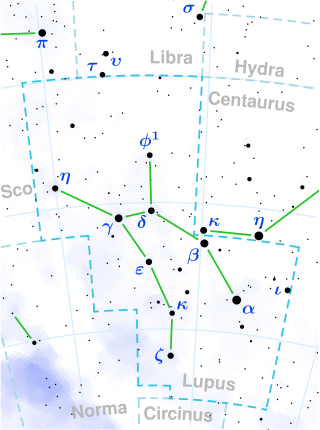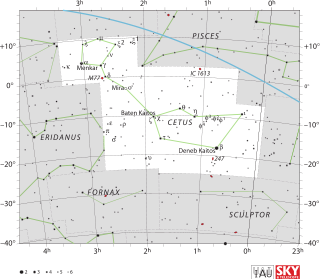
Hydrus is a small constellation in the deep southern sky. It was one of twelve constellations created by Petrus Plancius from the observations of Pieter Dirkszoon Keyser and Frederick de Houtman and it first appeared on a 35-cm (14 in) diameter celestial globe published in late 1597 in Amsterdam by Plancius and Jodocus Hondius. The first depiction of this constellation in a celestial atlas was in Johann Bayer's Uranometria of 1603. The French explorer and astronomer Nicolas Louis de Lacaille charted the brighter stars and gave their Bayer designations in 1756. Its name means "male water snake", as opposed to Hydra, a much larger constellation that represents a female water snake. It remains below the horizon for most Northern Hemisphere observers.

Castor is the second-brightest object in the zodiac constellation of Gemini. It has the Bayer designation α Geminorum, which is Latinised to Alpha Geminorum and abbreviated Alpha Gem or α Gem. With an apparent visual magnitude of 1.58, it is one of the brightest stars in the night sky. Castor appears singular to the naked eye, but it is actually a sextuple star system organized into three binary pairs. Although it is the 'α' (alpha) member of the constellation, it is half a magnitude fainter than 'β' (beta) Geminorum, Pollux.

Beta Hydri is a star in the southern circumpolar constellation of Hydrus. With an apparent visual magnitude of 2.8, this is the brightest star in the constellation. Based upon parallax measurements the distance to this star is about 24.33 light-years.

Alpha Pavonis, formally named Peacock, is a binary star in the southern constellation of Pavo, near the border with the constellation Telescopium.

Alpha Scuti, Latinized from α Scuti, is an orange-hued star in the southern constellation of Scutum. Originally part of the Aquila constellation, Alpha Scuti was a latter designation of 1 Aquilae. It is faintly visible to the naked eye with an apparent visual magnitude of 3.83. Based upon an annual parallax shift of 16.38 mas as seen from the Earth, it is located around 199 light years from the Sun. It is moving away from the Sun with a radial velocity of +36.5 km/s.

Alpha Trianguli is a spectroscopic binary star in the constellation of Triangulum. Based on parallax measurements obtained during the Hipparcos mission, it is approximately 63.3 light-years distant from the Sun. The brighter or primary component is named Mothallah.

Mu Andromedae is the Bayer designation for a star in the northern constellation of Andromeda. It has an apparent visual magnitude of 3.87, making it readily visible to the naked eye. Based upon parallax measurements, it is approximately 130 light-years from Earth. In the constellation, the star is situated about halfway between the bright star Mirach to the southwest and the Andromeda Galaxy (M31) to the northeast.

Alpha Lupi is a blue giant star, and the brightest star in the southern constellation of Lupus. According to the Bortle Dark-Sky Scale, its apparent visual magnitude of 2.3 makes it readily visible to the naked eye even from highly light-polluted locales. Based upon parallax measurements made during the Hipparcos mission, the star is around 460 light-years from the solar system. It is one of the nearest supernova candidates.

Alpha Pictoris is the brightest star in the southern constellation of Pictor. It has an apparent visual magnitude of 3.27, which is bright enough to be viewed from urban areas in the southern hemisphere. This star is close enough for its distance to be measured using parallax shifts, which yields a value of roughly 97 light-years from the Sun, with a 5% margin of error. Alpha Pictoris has the distinction of being the south pole star of the planet Mercury.
Pi2 Cygni, Latinized from π2 Cygni, is a triple star system in the northern constellation of Cygnus. It is visible to the naked eye about 2.5° east-northeast of the open cluster M39, having an apparent visual magnitude of 4.24. Based upon an annual parallax shift of 2.95 mas, it is located at a distance of roughly 1,100 light years from the Sun.

Alpha Lacertae, Latinised from α Lacertae, is a single white-hued star in the constellation of Lacerta, located 103 light-years from the Sun. It is the brightest star in Lacerta with an apparent visual magnitude of 3.76. The star is moving closer to the Earth with a heliocentric radial velocity of −4.5 km/s.

Lambda Ceti, Latinized from λ Ceti, is a B-type star of fifth-magnitude located in the constellation Cetus. Historically, the star bore the traditional name Menkar, although today that name is more commonly associated with α Ceti.

Beta Reticuli is binary star system in southern constellation of Reticulum. It is visible to the naked eye with an apparent visual magnitude of +3.84. Based upon an annual parallax shift of 33.49 mas, it is located some 97 light years from our Sun.
γ Hydri, Latinised as Gamma Hydri, is a solitary, red-hued star in the constellation Hydrus. It has an apparent visual magnitude of 3.26, making it easily visible to the naked eye at night. Based upon an annual parallax shift of 15.24 mas as measured from Earth, the system is located about 214 light-years from the Sun.

Delta Hydri, Latinized from δ Hydri, is a single, white-hued star in the southern constellation of Hydrus. It is bright enough to be faintly visible to the naked eye with an apparent visual magnitude of 4.09. The distance to this star, based upon an annual parallax shift of 23.35 mas, is about 140 light years. It is moving away from the Sun with a radial velocity of +6 km/s.

Epsilon Hydri, Latinized from ε Hydri, is a single, blue-white hued star in the southern constellation of Hydrus. It is a faint star with an apparent visual magnitude of 4.12, but it can be seen with the naked eye. Measurements made by the Hipparcos spacecraft showed an annual parallax shift of 21.48 mas, which provides a distance estimate of 152 light years. The star is moving away from the Sun with a radial velocity of +13.6 km/s. It is a member of the Tucana-Horologium moving group, an association of stars that share a common motion through space.

ν Hydri, Latinized as Nu Hydri, is a single star in the southern circumpolar constellation of Hydrus. It is orange-hued and faintly visible to the naked eye with an apparent visual magnitude of 4.76. This object is located approximately 331 light years from the Sun based on parallax, and is drifting further away with a radial velocity of +3 km/s. It is a member of the Ursa Major Moving Group of stars that share a common motion through space.

Zeta Hydri, Latinized from ζ Hydri, is a single, white-hued star in the southern constellation of Hydrus. It is faintly visible to the naked eye with an apparent magnitude of 4.83. This distance to this star can be estimated from its annual parallax shift of 11.47 mas, showing it to be about 284 light years away. It is moving further away from the Sun with a radial velocity of +3.6 km/s.

ν Octantis, Latinised as Nu Octantis, is a star in the constellation of Octans. Unusually, it is the brightest star in this faint constellation at apparent magnitude +3.7. It is a spectroscopic binary star with a period around 2.9 years. Parallax measurements place it at 19.4 parsecs (63 ly) from Earth.
Eta1 Hydri, Latinized from η1 Hydri, is a blue-white hued star in the southern constellation of Hydrus. It has an apparent visual magnitude of 6.76, which may be too faint to be visible to the naked eye. Based upon an annual parallax shift of 5.27 mas as measured from Earth, the system is located about 619 light years distant from the Sun. At that distance, the visual magnitude of the star is diminished by 0.10 magnitudes of extinction due to interstellar dust. The star is drifting further away with a heliocentric radial velocity of +15 km/s.













